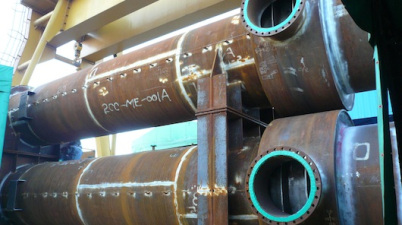Hastelloy grades for sulfuric acid applications at different temperatures
Sulfuric acid is a commonly used chemical in the processing sector. Its corrosive effect on service material varies significantly, based on contaminants, temperature and water concentration. It is a problem with micro process equipments with thin walls. These equipments are usually joined by diffusion bonding that may affect material’s properties due to high temperatures and prolong service durations.
Family of C grade super alloys such as Hastelloy C offer supreme resistance to oxidizing corrosive media and NiMo alloys with outstanding resistance to reducing corrosive media. This combination resulted in the most versatile corrosion resistant alloy in NiCrMo alloy, with outstanding corrosion resistance in diverse conditions usually occurring in CPI and other plants.
Hastelloy C also offers outstanding resistance to pitting and crevice corrosion in low pH, high chloride oxidizing conditions and has virtual resistance to chloride stress corrosion cracking. These features enable this alloy to use in the industrial applications for several years, however it had some limitations.
Hastelloy C4 and C22 are high corrosion resistant NiCrMo alloys with outstanding pitting and crevice corrosion resistance. The chemical composition of the suitable elements states the corrosion rate with stoichhiometric ratio of the elements. High resistance to oxidizing acids is attained at high and to reducing acids at low values. It shows that Hastelloy C22 has suitable corrosion resistance with respect to oxidizing and reducing acids. Hastelloy C4 and C276 grades have almost similar corrosion resistance. Based on their wide chemical resistance, these grades are one of the essential grades in the chemical plants.
Corrosion is one of the major reasons for the failure of process equipments due to lowered material thickness. Additionally, the process equipments are produced from a large number of thin, microstrucured sheets which are mainly connected by diffusion bonding. . During processing, they are subjected to high temperatures and long durations which is usually related with a reduction of material strength and development of precipitations at grain boundaries.
Sulfuric acid is commonly used in different concentrations in the chemical plants. Based on the source and ambient condition during production, it may include impurities and a water concentration that varies in the specific limits. During chemical transformation, strong heat of reactions may occur. It can be limited by micro process equipments, which have large surface to volume ratios.
Molybdenum has a significant role to reduce surface corrosion in non-oxidizing acids like sulfuric acid and to enhance the pitting resistance. The rate of corrosion or material variations were that considerable that the life cycles do not appear to be considerably sufficient for process equipments. Additionally, the outcomes were fluctuating and not consistent to different concentrations of sulfuric acid therefore a considerable life prediction for micro process equipments is not feasible.
Use of Hastelloy bar grades in sulfuric acid applications such as Hastelloy B3 is popular as these are high molybdenum alloys. They have a cubic face centered lattice, although, due to high molybdenum concentration unlike to standard stainless steels, the coefficient of thermal expansion is more comparable to that of ferritic steels. Hastelloy B3 contains significant magnitude of molybdenum to perform adequately in the different service conditions.


